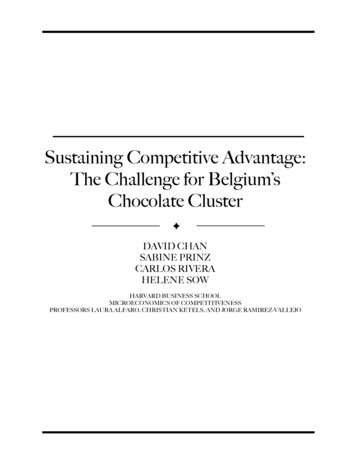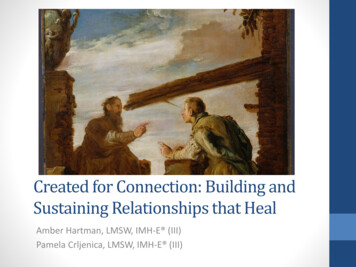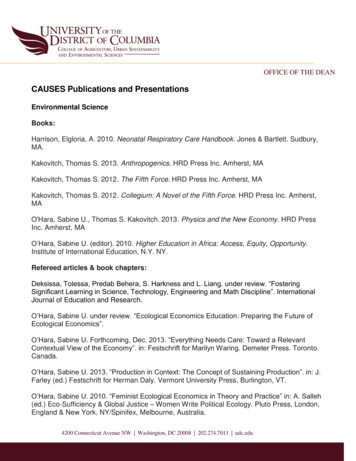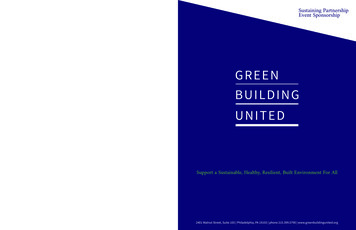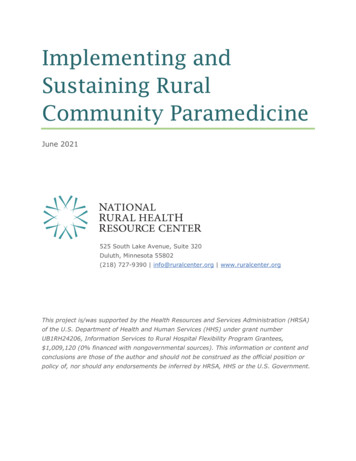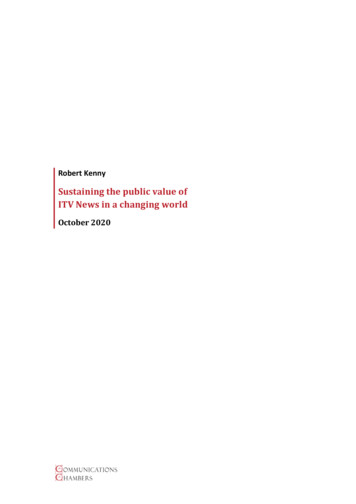
Transcription
Robert KennySustaining the public value ofITV News in a changing worldOctober 2020
About the AuthorRob Kenny is a founder of Communications Chambers. He hasextensive experience on issues of TMT policy and regulation,and PSB and news in particular.He has worked on PSB issues for clients such as the BBC, ITV,RTÉ, Virgin Media, COBA, the Broadcasting Authority ofIreland and the Belgian government, addressing funding,public value, market impact, distribution strategy, and manyother topics.He has also worked widely on news issues, including plurality,the business of news, and interventions to support news.Relevant clients have included the BBC, Sky, 21st Century Fox,News Corp, GMG, the Broadcasting Authority of Ireland andthe Australian Competition & Consumer Commission.Previously Rob headed strategic planning and corporatedevelopment for Hongkong Telecom, and corporatedevelopment for Level 3.DisclaimerThis is an independent report prepared for ITV. The opinionsoffered herein are purely those of the author. They do notnecessarily represent the views of ITV, nor the views of allCommunications Chambers members.[0]
Contents1.Executive Summary . 23.A rapidly changing news market . 72.Introduction . 63.1.3.2.3.3.Shifting platform preferenceNews economicsThe nature of news710124.1.4.2.4.3.4.4.4.5.4.6.ITV’s news offeringITV’s investment in newsConsumption of ITV NewsTrust in ITV NewsITV News during COVID-19Indirect benefits of ITV News1519212525265.1.5.2.5.3.Licence obligationsCommercial rationale todayLooking ahead2829306.1.6.2.6.3.6.4.6.5.6.6.Simulcasting nations and regions news live via the ITV Hub onlineA virtual online news channelImproved integration of news into ITV HubOriginal video and social media innovationCooperation with local newspaper groupsSupporting business capabilities3535353636377.1.7.2.7.3.7.4.Challenges to newspaper journalism and limited public tools to supportPSB news as source of journalism with existing mechanisms for public supportChallenges facing the commercial PSB regimeConclusion383839404.A news service for everyone: the current role of ITV News . 155.Why does ITV provide news services and what are their economics? . 286.How will ITV News continue to deliver public value? . 347.Implications for policy makers . 38[1]
1. Executive SummaryThis paper considers the unique and important role played byITV in the UK news market; how ITV might sustain that role asthe market develops; and some of the challenges that willneed to be overcome in the context of the up coming reviewof Public Service Broadcasting.The changing news marketThe news market has seen dramatic change, with the sharpdecline in newspaper circulations and the rise in onlineconsumption. This shift has put great pressure on theeconomics of newspaper journalism, with both circulationand advertising revenues threatened.Challenging economics and the rise of social media havedegraded the quality of much news, resulting in increased softnews and clickbait; cheap news (such as celebrity gossip);brief news; fake news; and news exhaustion. The newspapershave still struggled, however, to establish a viable massmarket ad funded model for news content online, and indeed,there may be no such model.However, to date TV news has been much more stable. Itcontinues to be the platform with the highest news reach,both in aggregate and across almost all demographics. It isalso highly rated, significantly outperforming other majorplatforms for perceived quality and trustworthiness. AsOfcom has noted, trustworthy PSB news is “particularlyimportant at a time when there is a proliferation of onlinenews of varying degrees of accuracy, including outright ‘fakenews’.” 1 The importance of reliable news with mass reach hasbeen starkly apparent during COVID.The role of ITV NewsITV is a substantial national and regional news provider witha deep history. In 2019 it provided 417 hours of national news,over 200 hours of nations news and around 170 hours ofEnglish regional news, at a cost of approximately 120m. Thisoutput covers both day-to-day reporting and investigativejournalism, delivered in a clear, engaging and nonsensationalist way. Nations and regions news is delivered in18 different local editions. ITV News is also available onlineand across social media with high levels of consumptionacross YouTube, Facebook and Twitter. ITV’s investmentsustains substantial entry level recruitment and training ofthe next generation of diverse journalists across the UK.ITV news is available for free everywhere across the UK and iswidely consumed. ITV is the second largest news provider inthe UK based on consumption with a greater reach than all UKprint newspapers (national and regional) combined. Its cross1Ofcom, Public service broadcasting in the digital age, 8 March 2018[2]
platform reach for all news and local news is 45% and 32%respectively (in each case, second only to the BBC). Accordingto BARB, ITV’s weekly reach for national and internationalnews alone is 16m adults, almost 5 times the reach of SkyNews.ITV’s TV news is also gaining on the BBC, the market leader. In2015-19, ITV’s early evening national bulletin saw 4% growthin audience, compared to a 12% decline for the BBC withviewing of the 6pm programme. ITV nations and regions newswas up by 9% in absolute terms since 2015 compared to a 13%fall in the BBC’s nations and regions news at 6.30pmThe demographics of ITV’s audience are also distinct.Compared to the BBC, it is younger, more C2DE, and strongerin Northern Ireland and the North East. ITV News is also highlytrusted. The Reuters Institute found it to be the most trustedof all the broadcast news services, and second only to the FTon a cross media basis.Trust in ITV has been particularly important during thepandemic. The audience for News at Ten, for instance, grewby 20% with similar increases of other news programmes.Ofcom’s survey found that 33% of the population weregetting their information about Coronavirus from ITV, secondonly to the BBC.Rationale for ITV’s provision of newsProvision of both national and regional news is specified inthe Channel 3 licences held by ITV, and this provides aguarantee of long term provision of quality and impartialnews at a time when a number of other news services areunder threat. News is seen by audiences as a critical part ofPSB. ITV’s news contract in turn plays a key role inunderwriting ITN as an independent commercial newsprovider also providing news for Channel 4 and Channel 5.National news bulletins generate advertising revenue for ITV(though Nations and regions news carries very littleadvertising). News also has reputational value. ITV doesexceed its licence quotas for national news (though this ispartly driven by the fact that news provision has high fixedcosts so incremental bulletins are relatively cheap). Thusnational news might appear in a purely commercial schedule,though this clearly wouldn’t be guaranteed. However,regional news would likely not given its cost and limitedrevenue. ITV’s online news is appreciably loss making, andserves as a beachhead for the future, rather thanrepresenting a sustainable service today. This reflects thebroader difficulties the newspaper groups have experiencedin creating a sustainable business model in advertisingfinanced news online.[3]
Looking ahead, the economics of TV news will come underincreasing pressure, not least because broadcast viewing isfalling as consumers shift online. Falling viewing both directlyaffects revenues from associated advertising and diminishesthe value of the Channel 3 licence benefits, that compensatefor and cross-subsidise the costs of news obligations. Clearlyon top of that, advertising category bans such as the proposedban on HFSS food and drink advertising before 9pm will harmthe overall economics of the main ITV PSB service in thefuture, affecting the economics of news.How to continue delivering public valueIf ITV is to sustain public value through news, it will need tomaintain broadcast news as well as grow online. ITV isexploring a number of possibilities for online, includingsimulcasts of nations and regions bulletins, live streaming ofkey news events in a sort of “virtual” news channel; increasedintegration of news into ITV Hub; new formats tailored forsocial media (and new distribution deals with social mediacompanies); and co-operation with local newspaper groups.Such steps would help ITV to deliver quality, impartial newsto distinct demographics online, just as it does on TV.However, there are a number of significant challenges tothese initiatives. As has been widely discussed, it is verydifficult to fund online news via advertising, and consumerwillingness-to-pay is limited (even if a subscription model wascompatible with fully delivering public value which it isarguably not).In the past news could be cross-subsidised from other areasof ITV’s business. However: The ‘PSB assets’ (spectrum and linear channelprominence) are of diminishing valueBroadcasters are increasingly dependent on globalonline intermediaries for distribution withdiminishing prominence and increasing demands forsubstantial shares of income in return fordistribution.TV advertising is increasingly fragile (and will befurther dented by the proposed ban on HFSS food anddrink advertising before 9pm)Young audiences are consuming less linear broadcastTVExpectations of PSBs are, if anything, rising, as thevery focussed (but limited) market based provision ofglobal players becomes more apparent.All that said, the commercial PSB ‘bargain’ is still a powerfultool. The Cairncross Review noted the importance of:“sources of funding [for public interest news],removed from direct government control. It will need[4]
institutional and financial structures that combine aguarantee of independence with adequate support.”The PSB bargain is just such a structure, and should be valuedand supported through the period of transition now upon us.The challenge in this will be to find ways to enable commercialPSB providers such as ITV to continue to fund high quality,trusted, mass reach news programmes as part of broaderbroadcast and online offerings that achieve mass reach in theUK. This problem is particularly acute given the increasingreliance that national providers such as ITV will have on globalonline distribution platforms to reach increasing parts of theaudience at scale.There are important lessons to learn from the experience ofthe newspapers, particularly in terms of the visibility andprominence of their content and, above all, the revenue lossthat they have experienced due to online distribution.A revised policy approach is needed to safeguard the publicvalue contribution of the PSBs, particularly in news, if as asociety we believe that there is no obvious substitute for thepublic value they deliver.[5]
2. IntroductionNews has seen dramatic changes over the last decade. Thebusiness model of most newspapers is under threat. Printadvertising (particularly classified) has collapsed, under thetwin pressures of competition from online advertising anddeclining circulation.With certain exceptions, newspapers have struggled to buildreplacement digital revenues. On the internet, they facefierce competition both for audience attention and foradvertising spend.As a result, public interest journalism is under threat. Thischallenge has been addressed by various reviews, mostrecently in the UK by the Cairncross Review. However,solutions remain elusive.To date, TV news has been more resilient. Until recently,viewership (unlike print readership) has been relativelysteady, and TV advertising has remained robust. As aconsequence, there has been far less policy focus on thefuture of TV news compared to that on the future ofnewspapers.However, TV viewing, particularly amongst youngeraudiences, is starting to fall. TV news consumption is comingunder pressure (though it remains the most importantplatform overall, and some providers, including ITV, areseeing growth); VOD providers such as Netflix are now seriouscompetitors for premium video content, albeit without news;and, improvements in broadband combined with ubiquitoussmartphones mean that video consumption habits are beingtransformed.Thus broadcasters are now approaching many of thechallenges that have so severely hurt the newspapers.Indeed, the situation online is potentially worse that than thenewspapers first faced, since then relationships withaudiences then were generally direct. Today they are oftenintermediated by powerful platforms.These challenges are crystalising just as COVID-19 hasprovided a powerful reminder of the importance to society ofwidely consumed, accurate and trusted news. Citizens haveturned to PSBs to understand the crisis, and to be informedon what they need to do to respond and keep themselves andthose around them safe.Thus PSB news (and PSB content more generally) is at a criticaljuncture. This paper looks at ITV News’ current position in thenews ecosystem; its prospects in the changing environment;and the mechanisms to ensure it continues to deliver publicvalue in the years ahead.[6]
3. A rapidlymarketchangingnews3.1. Shifting platform preferenceContinued resilience of TVThe key change in news consumption over the past decadehas been the continuing decline of newspapers (previouslythe #2 platform in terms of reach, behind TV), and the rise ofthe internet. However, throughout this fundamental changein news consumption, TV news has been surprisingly resilient.While there has been some year to year volatility, it remainsthe #1 platform for news by an appreciable margin. 2Figure 1: Reach of different news platforms 3TV75%Internet65%RadioNewspapers42%35%There are some important differences in news platform usageby demographic – unsurprisingly the young make heaviest useof the internet, for example. But for most demographics TV isthe most important platform:Ofcom has changed its methodology for its news consumption survey, so figures are not directlycomparable. However, in 2020 75% of respondents said they used TV for news, compared to 78% in20133Ofcom, News Consumption in the UK: 2020, 13 August 20202[7]
Figure 2: Use of different news platforms by demographic %20%10%0%16 - 34 35 - 5455 ABC1C2DETV is important not just because it is a widely used platform,but also because it is highly rated. On all quality attributesmeasured by Ofcom, TV scored highest amongst the majorplatforms (though magazines scored even higher). TV’sadvantage was particularly high for “is high quality” and“helps me understand what's going on in the world today”:Figure 3: Ratings of different news platforms 50%20%40%60%80%Is important to meIs high qualityIs accurateIs trustworthyIs impartialOffers a range of opinionsHelps me make up my mindHelps me understandHas a depth of analysisTVPrint newspapersRadioOth InternetSoc MediaThese high ratings are in part due to the obligations on TVnews to be impartial and accurate, and the more stringentregulations that apply during the course of elections andreferenda. However, the high ratings are not just a matter ofregulation. The radio broadcasters operate under the sameregulations, but score lower on all the ratings above. Theculture and levels of investment of the TV news providersclearly matters too.Ofcom, News consumption in the UK: 2020 data tables, 13 August 2020Ofcom, News Consumption in the UK: 2020, 13 August 2020. Percentages are share of regular usersgiving a score of 7-1045[8]
To date (in contrast to newspapers) there has limited focus onthe future commercial viability of TV news, because the TVbusiness model has been seen as more secure.Rapid decline of print newspapersAs we have noted, print newspapers have seen a substantial(and long-run) decline. Over just the last 8 years, thecirculation of paid-for nationals has seen a 50% decline.Figure 4:National newspaper circulation by title (m) 643The SunDaily Mail2Daily Mirror102000 2002 2004 2006 2008 2010 2012 2014 2016 2018Local newspapers too have seen declines. Mediatique reporta 34% drop in per-title circulation, 2007-17. 7 Even this figureis flattered by the inclusion of Metro and Evening Standard,two freesheets whose circulation has been robust. The figurefor the typical paid-for daily or weekly would be much worse.In addition local newspapers have seen numerous closures,with the number of titles falling from 1303 to 982. Combinedwith the decline in per-title circulation, this has resulted in a51% drop in total circulation.Rise of the internetThe internet is now very widely used for news, with 65%reporting it is a platform they use. (However, there is somesignificant regional variation – in Scotland and NorthernIreland the figures are 58% and 53% respectively).8Amongst the 65% using the internet, 45% use social media,and 41% are using news sites directly. Thus 24% are usingsocial media only. Thus social media is a key source of news,albeit as an intermediary rather than underlying provider.Indeed, Facebook (with reach of 36% amongst cross-platformnews users) only ranks behind BBC and ITV, and Google (23%)is of a similar scale to DMGT.ABCMediatique (for DCMS), Overview of recent dynamics in the UK press market, April 20188Ofcom, News Consumption in the UK: 2020, 13 August 202067[9]
Turning to underlying providers, the players with the largestreach online are the traditional news providers – the top fourare the BBC, Sky, the Guardian and the Mail. However,thereafter there is a mix of traditional and new players, withthe Huffington Post, Buzzfeed and MSN all securingworthwhile audiences. 9Overall, internet news provision (as opposed to social media)remains highly competitive. While the BBC is a clear leader,there is a very long tail, including the online offers of TVcompanies, radio stations and newspapers as well as a largenumber of digital natives.3.2. News economicsThese shifts in platform preference, and the rise of socialmedia, have had a dramatic impact on industry economics.Decline of print revenuesFor newspapers, continuing circulation falls directly impactcirculation revenue and indirectly impact advertising revenue,since page rates eventually fall to reflect smaller audiences.(While the advent of the internet has somewhat acceleratedcirculation declines, they have been ongoing for manydecades).The rise of internet advertising also represents seriouscompetition for newspapers’ advertising customers.Classified advertising (particularly valuable for local papers)was first to come under threat, but display advertising hasalso been badly affected. Until recently, broadcast advertisinghas been more resilient to internet competition, but there issome evidence this is starting to change. TV viewing is startingto fall as audiences spend more time online, and advertisingis following suit.Search for internet revenuesVirtually all news organisations have reacted to these threatsto their revenue by moving online. This is a natural responseto the fact that audiences now spend so much time online,and for news the real-time nature of the internet is helpful.However, news organisations face a far more intensecompetitive environment online. A given print newspapermay be the only way to reach a consumer with printadvertising on a particular day (since they are unlikely to readmore than one title). However, online consumers may visitdozens of sites per day that carry advertising.Further, in the online world, news providers are relativelysmall in terms of time spent (though they still have significant9Ofcom, News Consumption in the UK: 2020, 13 August 2020[10]
reach). In particular, they are dwarfed by the digitalplatforms.100%Google SitesMicrosoft90%FacebookAmazon SitesReach GroupBBC SitesNews UKSky SitesMail Online80%70%60%1,6001,400Hours spent (m)1,2001,00080060040040%20050%0Reach (amongst those online)Figure 5: Reach & time spent for major UK online properties 10For example, UK audiences spent 34m hours with the MailOnline in July 2020. They spent 1.4bn hours on Google sites.The scale of the digital platforms gives them more leveragewith advertisers; far greater ability to target niche audiences;and much lower unit costs (which are already low becausethey attract audiences using algorithms and user-generatedcontent, rather than employee-generated content). Inaggregate these factors make it very difficult for newsproviders to compete for advertising with the platforms.In addition to reaching audiences via their own websites,news providers reach audiences via the social mediaplatforms, in particular Facebook. While this does help retaina relationship with audiences, it has not been particularlylucrative. The competition for attention within Facebook isnot less intense than that in the wider internet, andFacebook’s scale (and the relative unimportance to them ofnews content) means that they are able to set terms of tradethat are unfavourable to news providers.Newspapers have felt the effect of these trends most acutely,not least because the decline of print consumption has leftthem most exposed to the harsh economic environment ofonline news. However, TV may follow the same path, as videoconsumption continues to move online.Thus far, there is little evidence that newspapers have beenable to establish a viable ad-funded model for news content,and there may simply be no such model. Indeed, even before10UKOM, UKOM Top 20 (accessed 28 September 2020). Figures are for July 2020[11]
COVID Group M forecast newsbrand ad revenue (across printand online) to fall from 1,376m in 2019 to 906m in 2024. 11Nor is the challenge limited to traditional providers. In 2019both Buzzfeed and Huffington Post scaled back their newsoperations.There are some titles (such as the New York Times and the FT)that have had success with subscription models. However,this opportunity is likely only available to a small number ofproviders – those providing unique, highly valued content topremium audiences.In light of these trends, the Cairncross Review found that “Itis still not possible to see with certainty the shape of a viablefuture for news publishing”. 12 Even if the subscription modelworks for some, this risks exacerbating information equality,where those willing and able to pay for online news receive adiet of hard news and investigative journalism, while othercitizens subsist on cheap, soft or sensationalist news that hasthe best chance of breaking even with advertising fundingalone.3.3. The nature of newsThe above trends have not just affected the economics ofnews and who provides it – they have changed the nature ofnews, in multiple ways.Soft news and clickbaitThe fierce competition for attention online has pushed somenews organisations to favour softer news (for example,celebrities) in their online offer, even as they have persistedwith harder news in their online news. Also, as consumptionhas atomised (with audiences selecting individual storiesrather than outlets), headlines have become marketing tools,giving rise to clickbait.Cheaper newsChallenging economics have also favoured soft news, which isgenerally cheaper to produce. Other impacts of tight budgetsinclude reduced investigative journalism, increased copyingof material from other outlets, churnalism, 13 blurring of theeditorial/ advertising boundary, and so on. This has affectedboth newspapers and digital-native news providers.Brief newsShorter attention spans, platform limits (such as Twitter’scharacter limits) and the immediate availability of a millionother attractions on a smartphone have pushed news outletstowards short and punchy content.Group M, This year, next year: UK media forecasts, December 2019Frances Cairncross, A sustainable future for journalism, 12th February 201913Articles that are lightly edited versions of press releases1112[12]
That said, there is undoubtedly still a market for longer formanalysis and discussion, In print, the Economist has been veryresilient and the Spectator has been growing. Onlineconsumers have doubled their use of podcasts over the lastfive years, and of the 7.1m UK weekly users, half listen tonews and current affairs podcasts. 14Fake newsSocial media gives non-traditional outlets the ability to reachmass audiences. Some bad actors have taken advantage ofthis to fabricate attention-grabbing, shareable stories. Insome cases this has been propaganda, in others it has beenfor commercial gain. Regardless, it injects fake news intoaudiences’ social media, and potentially corrodes their trustin reliable sources (traditional or otherwise).Media bypassPrior to social media, politicians and other figures’relationship with the public was largely via the media. Today,they can reach the public directly. @MayorofLondon has3.3m Twitter followers, and @10DowningSteet has 5.8m, forexample.Fact checkingBoth fake news and media bypass have created a greaterdemand for fact-checking, to counter content that may beheavily biased, or outright false.News exhaustion and dissatisfactionOnline news, and in particular its presence in people’s socialmedia feeds, means increased usage of news. Of UK newsusers, 47% report they are accessing news more than fiveyears ago, compared to 13% saying less. 15As a result, for some news can seem inescapable. This hasperhaps been exacerbated by the intensity and duration ofcertain stories, such as Brexit and Trump. In the US, 66% ofpeople report that they “Are worn out by the amount ofnews”. 16Ofcom, Audio on demand: the rise of podcasts, 30 September 2019YouGov (for DCMS), Newspaper Habits, 11 February 201916Pew Research Center, Americans’ news fatigue isn’t going away – about two-thirds still feel worn out,26 February 20201415[13]
Audiences also perceive that the quality of news is falling:Figure 6: Reported change in quality of newsover the last five years ghtlyImplications for PSBPSB news is accurate, widely trusted, substantive and familiar.These attributes are underpinned by an effective regulatorlooking not just at standards but also judging quality, accuracyand audience opinion. The implication of the trends discussedabove is that these attributes of PSB news are ever morevaluable.As Ofcom has noted, trustworthy PSB news is “particularlyimportant at a time when there is a proliferation of onlinenews of varying degrees of accuracy, including outright ‘fakenews’.” 18The recent report on PSB from the House of Lords SelectCommittee on Communications and Digital reported that“many witnesses said that the provision of impartial andtrusted news is crucial to public service broadcasting”. 19 TheCommittee took the view that PSB:“faces unprecedented competition from global giants [Th]e relevance of public service broadcasting is beingchallenged at a time when they are needed ever more toensure the provision of trustworthy news and informationand to guarantee a reliable supply of diverse, high qualityprogrammes for UK audiences, available to all.”YouGov (for DCMS), Newspaper Habits, 11 February 2019Ofcom, Public service broadcasting in the digital age, 8 March 201819House of Lords Select Committee on Communications and Digital, Public service broadcasting: as vitalas ever, 5 November 20191718[14]
4. A news service for everyone:the current role of ITV NewsITV is one of the most important providers of national, nationsand regional news in the UK. It has a long and distinguishedhistory and a strong culture underpinning its commitments toimpartiality and accuracy. It also has the scale and thewherewithal to tell challenging stories and stand up to thepowerful where necessary.In this section we describe ITV News, setting out the offering,the investment, the audience and their attitudes, and thebenefits.4.1. ITV’s news offeringNational newsITV offers multiple national news programmes – GoodMorning Britain, lunch and early evening bulletins, the Newsat Ten and (once per week) the Tonight programme, coveringcurrent affairs.In 2019 ITV provided 417 hours of national and internationalnews, up from 399 hours in 2013, and compared to a quota of365 hours. Of this 229 hours were in peak (vs a quota of 125hours). 20The ITV News editorial agenda and tone of voice are based ona belief that the service should not talk down to its audience,but rather should explain in a clear and engaging way. Norshould it sensationalise its content, and or put the interests ofinstitutions ahead of those of ordinary people.National news is anchored by familiar faces such as TomBradby, Julie Etchingham and Rageh Omaar. They aresupported by specialist editors including Robert Peston, RohitKachroo and Emily Morgan.Day-to-day reporting is coupled with investigative journalism.Generally each specialist will be working on one such story inparallel with coverage of the events of the day. Examples ofsuch stories include an undercover investigation of foodsafety breaches at a chicken-processor (together with theGuardian), and Rohit Kachroo’s trip to Syria to interview theISIS ‘Beatles’.ITV’s national news benefits from the company’s regionalpresence, based both on the Nations and regions news teams,and ITN teams positioned across the country on ITV’s behalf.This helps ITV ensure a nationally representative approach.(Its viewing figures are particularly strong
Trust in ITV News 25 4.5. ITV News during COVID -19 25 4.6. Indirect benefits of ITV News 26 . difficult to fund online news via advertising, and consumer willingness-to-pay is limited (even if a subscription model was . reliance that national providers such as ITV will have on global







